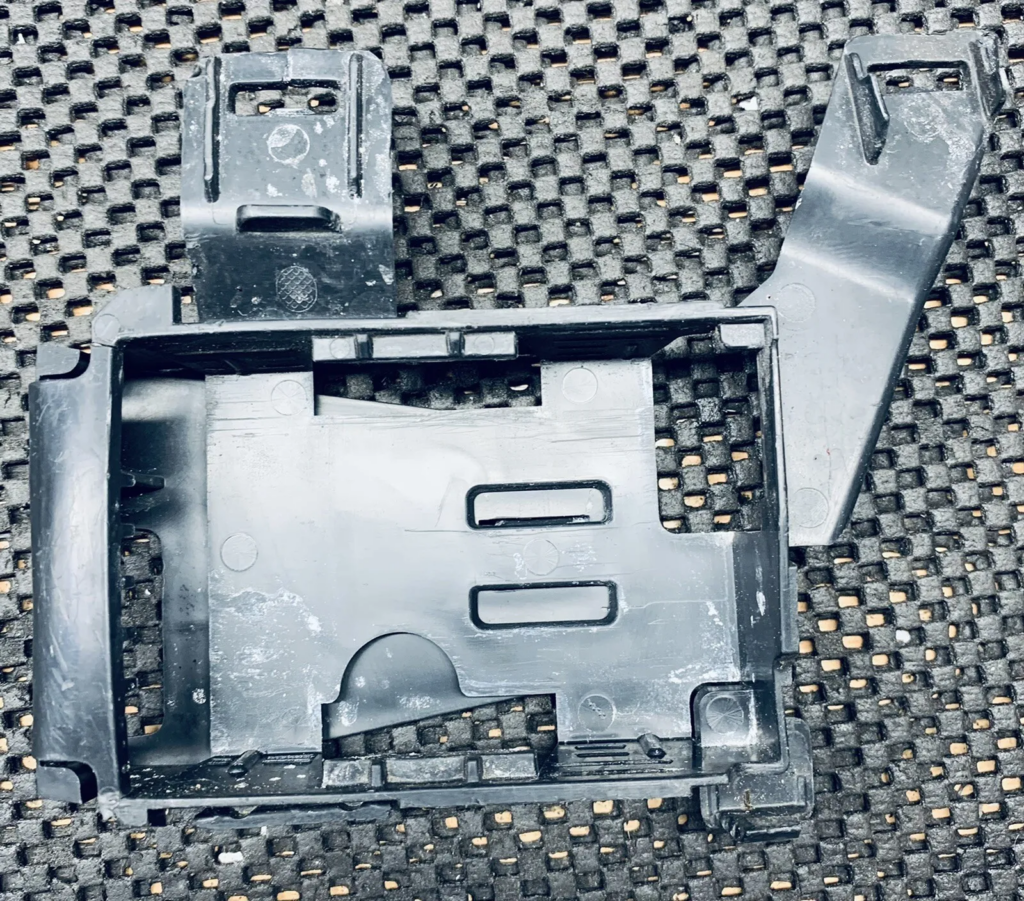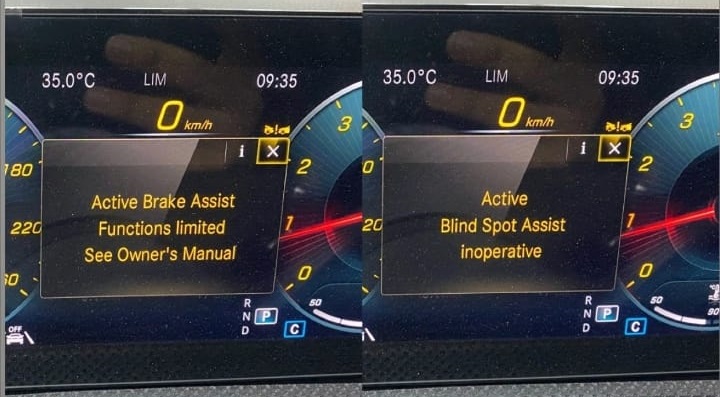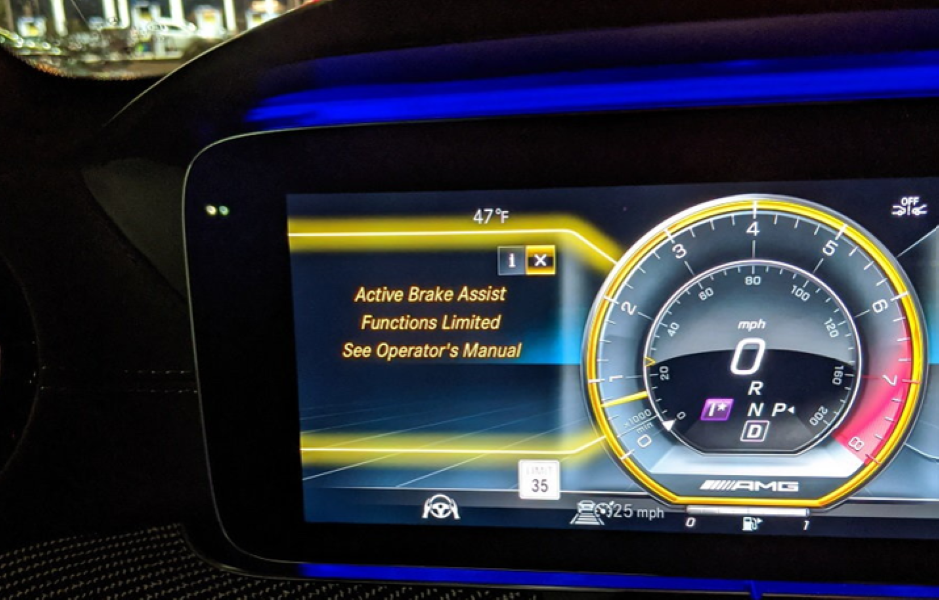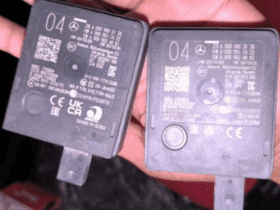Table of Contents
Active Brake Assist Functions Limited Mercedes: Causes, Diagnosis & Fix
When you see the warning “Active Brake Assist Functions Limited” on your Mercedes dashboard, it means that the automatic emergency braking system isn’t functioning at full capacity.
This alert indicates that your car’s Active Brake Assist feature a key part of the Mercedes Intelligent Drive safety suite has detected a fault or limitation affecting its radar, camera, or control units.
Although your standard brakes still work, the collision-avoidance braking feature may not intervene as expected.
This guide featuring two real-world Mercedes case studies explains what causes this warning, how it’s diagnosed, and the professional steps to restore full system functionality.
For related guides covering ABS, ESP, and Brake Assist faults, visit: Mercedes Brake System Problems: ABS, ESP & Brake Assist Guide
How Active Brake Assist Works
Active Brake Assist constantly monitors the road ahead using:
- – Front radar sensor (usually behind the Mercedes emblem)
- – Multifunction camera (behind the windshield)
- – Control units such as the IC Radar, ESP, and Distronic module
When a potential collision is detected, the system will:
- 1. Warn the driver with visual and audible alerts.
- 2. Pre-charge the brakes for faster reaction.
- 3. Automatically apply braking if the driver doesn’t respond.
It activates above approximately 7 km/h (4 mph) and operates in both urban and highway conditions.
Common Causes of “Functions Limited” Warning
| Cause | Description |
|---|---|
| Sensor obstruction | Dirt, mud, or snow blocking the radar or camera |
| Control-unit fault | Failure in ESP or Intelligent Drive module |
| Moisture or corrosion | Water ingress in radar connectors or wiring harness |
| Low or unstable voltage | Weak main or auxiliary battery causing CAN errors |
| Post-collision misalignment | Radar displacement after bumper damage |
| Software error | Incomplete module update or coding issue |
Case Study 1: Mercedes-Benz E-Class W213
Customer Complaint
A Mercedes-Benz E-Class W213 owner reported a repeated “Active Brake Assist Functions Limited – See Owner’s Manual” warning appearing at every startup.

Diagnosis
- – A full system scan with the Autel MaxiCOM tool revealed no critical brake faults, but a radar misalignment code was stored.
- – Visual inspection showed the front radar sensor had come loose from its bracket after a minor bumper deformation.

Repair
- 1. The radar sensor was secured and re-mounted to its original position.
- 2. The technician performed an on-road radar calibration using Autel MaxiCOM.
- 3. All fault codes were cleared and the system retested.
Result: The warning disappeared and Active Brake Assist operated normally.
This case emphasizes that even a minor sensor shift can disable key safety features.
Case Study 2: Mercedes-Benz CLA 250
Symptoms
The driver reported multiple warnings:
- – Active Brake Assist Functions Limited
- – Active Blind Spot Assist Inoperative
- – Active Distance Assist Inoperative
- – Active Lane Keeping Assist Inoperative


Diagnosis
A multi-system fault like this often points to voltage fluctuation or CAN communication loss.
Using XENTRY, the technician scanned the Intelligent Drive, ESP, and IC Radar modules and found intermittent radar communication errors.
Repair Procedure
- 1. Battery voltage tested – reading low at 12.1 V.
- 2. Main battery replaced, and wiring inspected for corrosion.
- 3. Front radar sensor cleaned and recalibrated.
- 4. Software update applied to the Intelligent Drive control unit.
Outcome: All warnings cleared after a short drive; full ADAS functions restored.
For more details in the following link; Active Brake Assist Functions Limited Mercedes : Case Study & Solution
DIY vs Professional Diagnosis
| Task | DIY-Friendly | Professional Recommended |
|---|---|---|
| Clean radar/camera area | Yes | – |
| Check battery voltage | Yes | – |
| Inspect fuse and connectors | Possible | For safety |
| Recalibrate radar | No | Dealer/XENTRY required |
| Replace radar or module | No | Specialist only |
| Perform software update | No | Dealer only |
How to Prevent “Active Brake Assist Functions Limited”
1. Keep Sensors Clean
Gently remove ice, mud, or insects from the bumper and emblem area. Avoid abrasive cleaning or high-pressure jets aimed directly at the radar.
2. Protect During Car Washes
Choose touchless washes or manual cleaning. Harsh scrubbing may misalign the radar sensor.
3. Recalibrate After Repairs or Collisions
Any front-bumper, grille, or windshield work requires radar alignment using OEM tools.
4. Monitor Battery Health
A weak main or auxiliary battery often causes intermittent CAN communication faults.
5. Schedule Regular Diagnostics
Ask your technician to perform a scan and sensor alignment check during maintenance intervals.
Where Is the Radar Sensor Located?
On most Mercedes E-Class and CLA models, the radar sensor is mounted behind the front bumper, typically on the right-hand side near the Mercedes emblem.
This position allows a clear forward field of vision for Active Brake Assist and other Intelligent Drive systems.

How to remove the Mercedes E-Class W213 radar sensor ?
Removing the radar sensor on a Mercedes E-Class W213 requires careful handling, as the sensor is a sensitive component crucial to the vehicle’s Active Brake Assist system. Here’s a general step-by-step guide on how to remove the radar sensor:
- 1: Remove the front bumper.
- 2: Remove the shock absorber from the front bumper.
- 3: Remove the pedestrian protection sensors along with the shock absorber from the front bumper.
- 4: Unlock the electrical connector and disconnect it.
- 5: Unscrew the screw and remove the bracket.
- 6: Remove the Active Brake Assist unit from the front bumper.
How Mercedes Emergency Braking Works
The radar sensor and camera continuously track vehicles and pedestrians ahead.
When a collision risk is detected, the system:
- 1. Warns the driver,
- 2. Pre-charges brake pressure, and
- 3. Applies automatic braking if necessary.
It can even bring the vehicle to a complete stop at low speeds, reducing collision severity or avoiding impact altogether.

Limitations of Active Brake Assist
Even with advanced algorithms, certain conditions can reduce system performance:
- – Heavy rain, snow, or fog
- – Dirty or misaligned sensors
- – Low visibility or glare
- – Low battery voltage
Regular calibration and preventive cleaning help maintain peak performance.
FAQ: Active Brake Assist Functions Limited Mercedes
Q1: What does “Active Brake Assist Functions Limited” mean?
It indicates a fault or limitation in the radar or camera system that affects the automatic emergency braking function.
Q2: Can I still drive with this warning?
Yes, but drive cautiously the emergency braking feature may not intervene in time.
Q3: How do I reset the warning?
Fix the underlying cause, then clear codes with XENTRY or an OBD-II tool. Cleaning the radar and restarting may reset temporary faults.
Q4: What are the most common causes?
Radar obstruction, misalignment, low voltage, or moisture in connectors.
Q5: How much does a radar sensor replacement cost?
Typically $700–$1,200, depending on model and calibration labor.
Conclusion
The “Active Brake Assist Functions Limited” message is your Mercedes telling you that its automatic emergency braking is not fully available.
In both case studies, simple causes sensor misalignment or low voltage triggered complex dashboard alerts.
Addressing the issue quickly ensures your collision-avoidance system remains reliable.
Routine maintenance, clean sensors, and battery checks can prevent reoccurrence and keep your Mercedes safety systems performing perfectly.
For more brake and stability troubleshooting, visit: Mercedes Brake System Problems: ABS, ESP & Brake Assist Guide
Author Bio
Mercedes Expert is an automotive technical trainer and Mercedes-Benz diagnostics expert with extensive hands-on experience in XENTRY, DTS Monaco, and advanced system troubleshooting. He specializes in transforming real workshop case studies into structured learning content to help technicians, car owners, and enthusiasts understand complex vehicle systems.
Last update: October 2025
— Salim, Mercedes Expert
Independent specialist in Mercedes-Benz diagnostics, CAN Bus analysis, troubleshooting case studies, and EV systems.







Leave a Reply